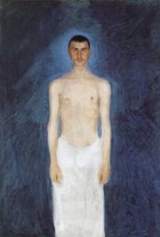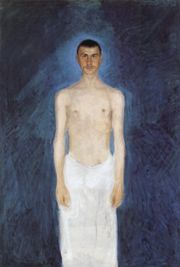
Richard Gerstl
Encyclopedia

Austria
Austria , officially the Republic of Austria , is a landlocked country of roughly 8.4 million people in Central Europe. It is bordered by the Czech Republic and Germany to the north, Slovakia and Hungary to the east, Slovenia and Italy to the south, and Switzerland and Liechtenstein to the...
n painter and draughtsman known for his expressive psychologically insightful portraits, his lack of critical acclaim during his lifetime, and his affair with the wife of Arnold Schoenberg
Arnold Schoenberg
Arnold Schoenberg was an Austrian composer, associated with the expressionist movement in German poetry and art, and leader of the Second Viennese School...
which led to his suicide.
Richard Gerstl was born in a prosperous civil family, Emil Gerstl, a Jewish merchant, and Maria Pfeiffer, non-Jewish woman. He visited the Viennese ' onMouseout='HidePop("86150")' href="/topics/Josefstadt">Josefstadt
Josefstadt
Josefstadt is the eighth district of Vienna . It is near the center of Vienna and was established as a district in 1850, but borders changed later. Josefstadt is a heavily populated urban area with many workers and residential homes.It has a population of 22,057 people...
), but he had to leave because of difficulties of discipline.
Early in his life, Gerstl decided to become an artist, much to the dismay of his father. After performing poorly in school and being forced to leave the famed Piaristengymnasium in Vienna
Vienna
Vienna is the capital and largest city of the Republic of Austria and one of the nine states of Austria. Vienna is Austria's primary city, with a population of about 1.723 million , and is by far the largest city in Austria, as well as its cultural, economic, and political centre...
as a result of "disciplinary difficulties," his financially stable parents provided him with private tutors. In 1898, at the age of fifteen, Gerstl was accepted the Academy of Fine Arts Vienna
Academy of Fine Arts Vienna
The Academy of Fine Arts Vienna is an institution of higher education in Vienna, Austria.- History :The Academy of Fine Arts Vienna was founded in 1692 as a private academy by the court-painter Peter Strudl, who became the Praefectus Academiae Nostrae. In 1701 he was ennobled as Baron of the Empire...
where he studied under the notoriously opinionated and difficult Christian Griepenkerl
Christian Griepenkerl
Christian Griepenkerl was a German painter and professor at the Academy of Fine Arts Vienna.Griepenkerl was born to one of Oldenburg's leading families...
. Gerstl began to reject the style of the Vienna Secession
Vienna Secession
The Vienna Secession was formed in 1897 by a group of Austrian artists who had resigned from the Association of Austrian Artists, housed in the Vienna Künstlerhaus. This movement included painters, sculptors, and architects...
and what he felt was pretentious art. This eventually prompted his vocal professor to proclaim, "The way you paint, I piss in the snow!"
Frustrated with the lack of acceptance of his non-secessionist painting style, Gerstl continued to paint without any formal guidance for two years. For the summers of 1900 and 1901, Gerstl studied under the guidance of Simon Hollósy
Simon Hollósy
Simon Hollósy ; was a Hungarian painter. He was considered one of the greatest Hungarian representatives of 19th century Naturalism and Realism. Hollósy was not productive as an artist: he was in search of atmospheres and his productivity was confined to teaching...
in Nagybánya. Inspired by the more liberal leanings of , Gerstl once again attempted formal education. Unfortunately, his refusal to participate in a procession in honor of Emperor Franz Joseph I of Austria
Franz Joseph I of Austria
Franz Joseph I or Francis Joseph I was Emperor of Austria, King of Bohemia, King of Croatia, Apostolic King of Hungary, King of Galicia and Lodomeria and Grand Duke of Cracow from 1848 until his death in 1916.In the December of 1848, Emperor Ferdinand I of Austria abdicated the throne as part of...
further ostracized him and led to his departure. Gerstl felt that taking part in such an event was "unworthy of an artist." His final exit from Lefler's studio took place in 1908.
In 1904 and 1905, Gerstl shared a studio with his former academy classmate and friend, Viktor Hammer. Although Hammer had assisted in Gerstl's admittance to Lefler's tutelage and their relationship was friendly, it is difficult to determine how close the two men were as Gerstl did not associate with other artists. Regardless of their personal feelings, by 1906, Gerstl had acquired his own studio.
Although Gerstl did not associate with other artists, he did feel drawn to the musically inclined; he himself frequented concerts in Vienna. Around 1907, he began to associate with composers Arnold Schoenberg
Arnold Schoenberg
Arnold Schoenberg was an Austrian composer, associated with the expressionist movement in German poetry and art, and leader of the Second Viennese School...
and Alexander von Zemlinsky
Alexander von Zemlinsky
Alexander Zemlinsky or Alexander von Zemlinsky was an Austrian composer, conductor, and teacher.-Early life:...
, who lived in the same building at the time. Gerstl and Schoenberg developed a mutual admiration based upon their individual talents. Gerstl apparently instructed Schoenberg in art.
During this time, Gerstl moved into a flat in the same house and painted several portraits of Schoenberg, his family, and his friends. These portraits also included paintings of Schoenberg's wife Mathilde, Alban Berg
Alban Berg
Alban Maria Johannes Berg was an Austrian composer. He was a member of the Second Viennese School with Arnold Schoenberg and Anton Webern, and produced compositions that combined Mahlerian Romanticism with a personal adaptation of Schoenberg's twelve-tone technique.-Early life:Berg was born in...
and Zemlinsky. His highly stylized heads anticipated German expressionism
Expressionism
Expressionism was a modernist movement, initially in poetry and painting, originating in Germany at the beginning of the 20th century. Its typical trait is to present the world solely from a subjective perspective, distorting it radically for emotional effect in order to evoke moods or ideas...
and used pastel
Pastel
Pastel is an art medium in the form of a stick, consisting of pure powdered pigment and a binder. The pigments used in pastels are the same as those used to produce all colored art media, including oil paints; the binder is of a neutral hue and low saturation....
s as in the works by Oskar Kokoschka
Oskar Kokoschka
Oskar Kokoschka was an Austrian artist, poet and playwright best known for his intense expressionistic portraits and landscapes.-Biography:...
. Gerstl and Mathilde became extremely close and, in the summer of 1908, she left her husband and children to travel to Vienna with Gerstl. Schoenberg was in the midst of composing his Second String Quartet
String quartets (Schoenberg)
The Austrian composer Arnold Schoenberg published four string quartets, distributed over his lifetime. These were the String Quartet No. 1 in D minor, Op. 7 , String Quartet No. 2 in F sharp minor, Op. 10 , String Quartet No. 3, Op. 30 , and the String Quartet No. 4, Op...
, which he dedicated to her. Mathilde rejoined her husband in October.
Distraught by the loss of Mathilde, his isolation from his associates, and his lack of artistic acceptance, Gerstl entered his studio during the night of November 4, 1908 and apparently burned every letter and piece of paper he could find.. Although many paintings survived the fire, it is believed that a great deal of his artwork as well as personal papers and letters were destroyed. Other than his paintings, only eight drawings are known to have survived unscathed. Following the burning of his papers, Gerstl hanged himself in front of the studio mirror and somehow managed to stab himself as well.
The incident had a significant impact on Arnold Schoenberg and his "drama with music" (i.e., opera) Die Glückliche Hand
Die glückliche Hand
Die glückliche Hand , , is a Drama mit Musik by Arnold Schoenberg in four scenes. It was composed between 1910 and 1913. Like Erwartung, composed a year earlier, it was heavily influenced by Otto Weininger's book Sex and Character. Unlike Erwartung, Schoenberg wrote the libretto for Die glückliche...
is based on these events.
After his suicide at the age of twenty-five, his family took the surviving paintings out of Gerstl's studio and stored them in a warehouse until his brother Alois showed them to the art dealer Otto Kallir in 1930 or 1931. Although Gerstl had never managed to exhibit a show during his lifetime, Kallir organized an exhibition at his Neue Galerie. Shortly afterward, the Nazi presence in Austria hindered the further acclaim of the artist and it was not until after the war that Gerstl was known in the United States. Sixty-six paintings and eight drawings attributed to Gerstl are known, although it is possible he destroyed many more or that others could have been lost over the years.

